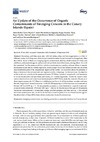Please use this identifier to cite or link to this item:
https://accedacris.ulpgc.es/jspui/handle/10553/74571
| Title: | An update of the occurrence of organic contaminants of emerging concern in the Canary Islands (Spain) | Authors: | Torres-Padrón, María Esther Montesdeoca-Esponda, Sarah Santana-Viera, Sergio Guedes-Alonso, Rayco Herrera-Melián, José Alberto Sosa-Ferrera, Zoraida Santana-Rodríguez, José Juan |
UNESCO Clasification: | 2301 química analítica | Keywords: | Canary Islands Emerging Contaminants Extraction Monitoring Wastewater Treatments |
Issue Date: | 2020 | Journal: | Water (Switzerland) | Abstract: | Nowadays, activities associated with industries, cities, and leisure generate a number of different wastes, including many chemical pollutants that enter the environment and negatively affect the wildlife. Some of them are emerging organic contaminants (EOCs), which include UV filters and stabilizers, antineoplastic agents, and natural and synthetic steroid hormones, among others. It is well demonstrated that the presence of this kind of contaminants may produce adverse effects in aquatic environments and also in marine organisms. Even though the Canary Islands (Spain) are one of the most biodiverse parts of the temperature regions of the world, little is known about the presence of these substances in the environment and organisms in the archipelago. For that purpose, the objective of this work was to evaluate the presence of some UV filters, cytostatic compounds, and hormones in water (wastewater and seawater), sediments, and marine organisms. Moreover, we evaluated conventional and natural wastewater treatment plants (WWTPs) to study the removal efficiencies of these target compounds. UV filters and stabilizers were found in all the analysed samples and were the only target family found in seawater (with UV-329 appearing at all the locations at concentrations between 67.5 and 859 ng L??1). Some cytostatic compounds were detected in hospital wastewater at concentrations between 375.8 and 1851 ng L??1, but not in the analysis of sludge or fish samples. Hormones were detected in wastewater, sludge, and fish samples, and their removal in the natural treatment system (over 76% for all the hormones) allowed to prove it as an efficient technology for the elimination of these EOCs from urban wastewaters in small communities. | URI: | https://accedacris.ulpgc.es/handle/10553/74571 | ISSN: | 2073-4441 | DOI: | 10.3390/w12092548 | Source: | Water (Switzerland) [EISSN 2073-4441], v. 12 (9), 2548, (Septiembre 2020) |
| Appears in Collections: | Artículos |
SCOPUSTM
Citations
11
checked on Jun 8, 2025
WEB OF SCIENCETM
Citations
11
checked on Jun 8, 2025
Page view(s)
261
checked on Dec 7, 2024
Download(s)
349
checked on Dec 7, 2024
Google ScholarTM
Check
Altmetric
Share
Export metadata
Items in accedaCRIS are protected by copyright, with all rights reserved, unless otherwise indicated.
